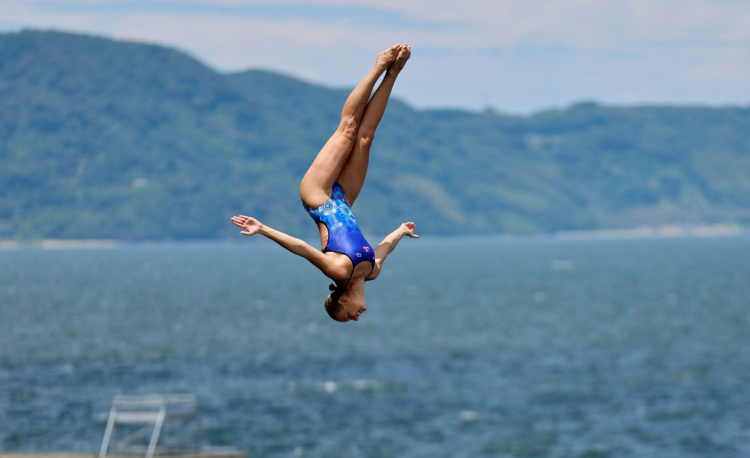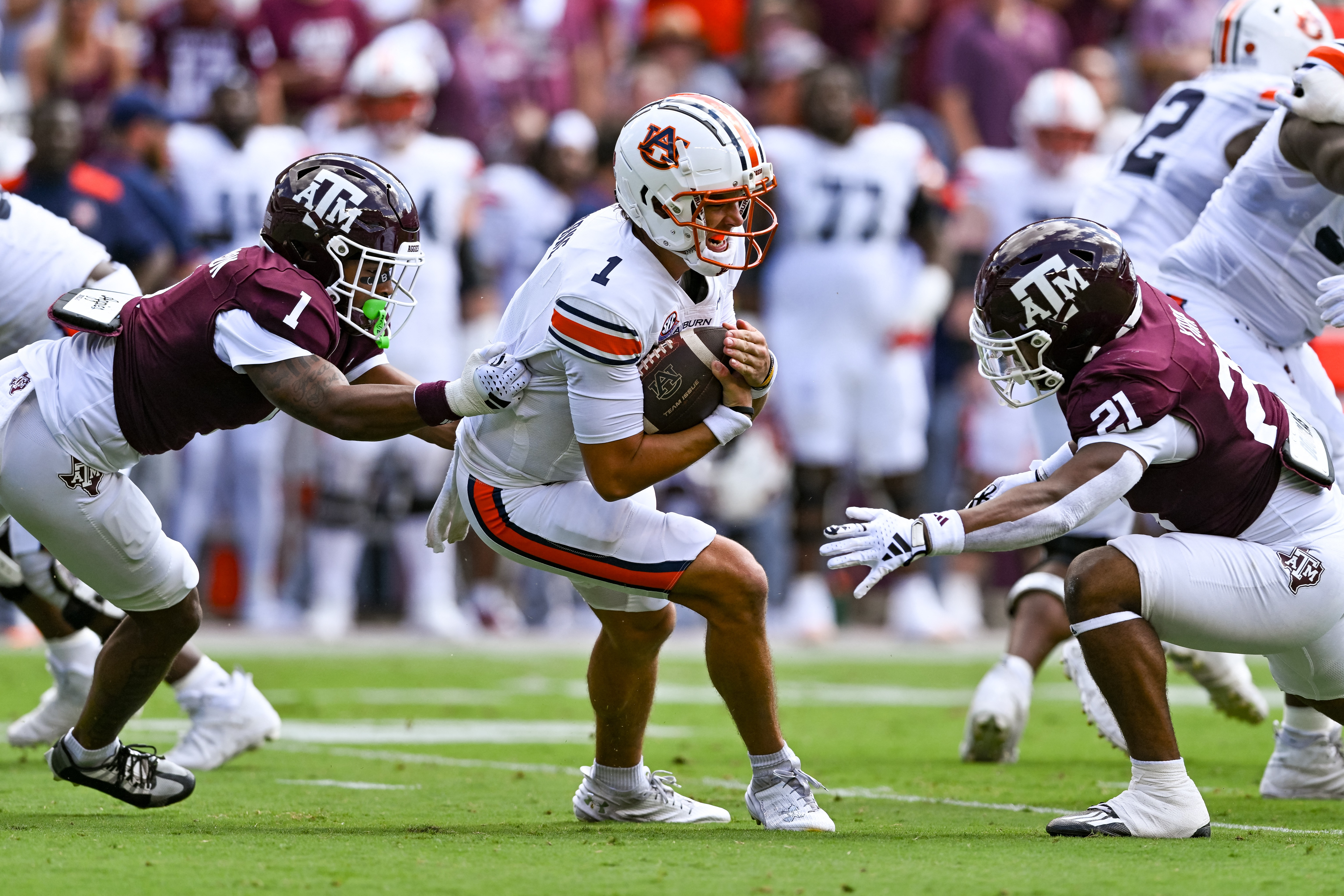You are viewing 1 of your 1 free articles
Hamstring Power: Isometric Training
Danny Lum provides practitioners with recommendations on the inclusion of isometric hamstring training. He discusses a progressive guide on performing the isometric mode for two hamstring exercises.
Sports participation has many positive effects on both physical and mental health. Beyond the numerous advantages, a major worry is the possibility of injury. Hamstring injuries are a persistent problem that affects individual and team performance(1). Hamstring injuries occur in field-based team sports at a rate of 0.81 per 1000 hours(2). Apart from the loss in training and playing time, the prevalence of hamstring injuries also has financial repercussions.
Hence athletes need to perform adequate hamstring strength training to reduce the injury risk or proper rehabilitation in the case of an injured hamstring.
Multiple hamstring rehabilitation protocol recommendations exist that include varying modes of exercises (isometric, eccentric, and sprinting)(3,4-6). There are several advantages to including isometric training in a rehabilitation program. Firstly, isometrics effectively assist with pain management. For instance, 45 seconds of isometric knee extension performed five times at 70% of the maximum voluntary contraction reduces patellar discomfort for 45 minutes(7). Since pain is frequently present throughout the acute healing stages, decreasing pain perception while performing rehabilitation exercises may improve program compliance. Secondly, before high eccentric loading, doing isometric contractions lessens the experience of delayed onset muscle soreness(8). Thirdly, its positive effects on tendon stiffness, a physical quality crucial for lowering the risk of tendon damage and rate force development(9). Finally, isometric training can also result in increased fascicle length, which is one of the factors in reducing the risk of hamstring injury(3,10).
“…isometric training for the hamstring muscles offers numerous benefits in pre-and rehabilitation programs for athletes.”
The hamstring muscles consist of a bi-articular semimembranosus, semitendinosus, and biceps femoris long head and a mono-articular biceps femoris short head. Although the hamstring muscles may perform similar roles of hip extension and knee flexion, each hamstring muscle operates differently and over different lengths(11). In addition, the action leading to injury for each muscle may differ. For example, athletes injure the biceps femoris more frequently than other muscles during sprint running, while the semimembranosus is more commonly injured while over-stretching, such as kicking(11). Each muscle produces the highest force at different joint ranges of movement(11). For example, semitendinosus – hip angle at 0° and knee flexion angle at 10-20° or hip flexion angle at 45° and knee flexion angle at 60-70°, and biceps femoris long head - hip flexion angle at 45° and knee flexion angle at 10-30°(11). Hence, practitioners should include various exercises in training to optimize the adaptations of all hamstring muscles.
Isometric Hamstring Hip Thrust
For this exercise, the athlete should first position the heel of the foot and upper back (just below the scapular) on two platforms of similar height. At the bottom range of movement, adopt a knee flexion angle of about 40-50° and a hip flexion angle of about 60-70° (see figure 1a). At the top range of movement, the knee angle should remain similar to the bottom range, and the hip flexion angle should be close to 0° (see figure 1b). These joint positions are comparable to that during the late swing and ground contact phases of sprinting.
FIGURE 1: ISOMETRIC HAMSTRING HIP THRUST

A - Bottom position, B- Top position
Hold Isometric
During the acute phase of the injury, the athlete may perform the exercise bilaterally to manage the pain and intensity, then progress to unilateral. They may start by holding the top and bottom positions for 10-30s for 1-3 sets for each position. A barbell may be placed on the abdomen, between the anterior superior iliac spine and belly button, to increase the intensity (see figure 2a and 2b).
FIGURE 2: ISOMETRIC HAMSTRING HIP THRUST WITH LOAD
 A - Bottom position, B- Top position
A - Bottom position, B- Top position
Push Isometric
As the athlete can perform high-intensity contraction pain-free, they can transit to performing the hamstring hip thrust with push isometric (see figure 3a and 3b). They may perform >70% maximum voluntary contraction for 2-3 sets of 10-30s at each position. Then progress to performing ~100% rapid maximum voluntary contraction for 2-3 sets of 5 repetitions with 1-3s sustained contraction at each position.
FIGURE 3: PUSH ISOMETRIC HAMSTRING HIP THRUST
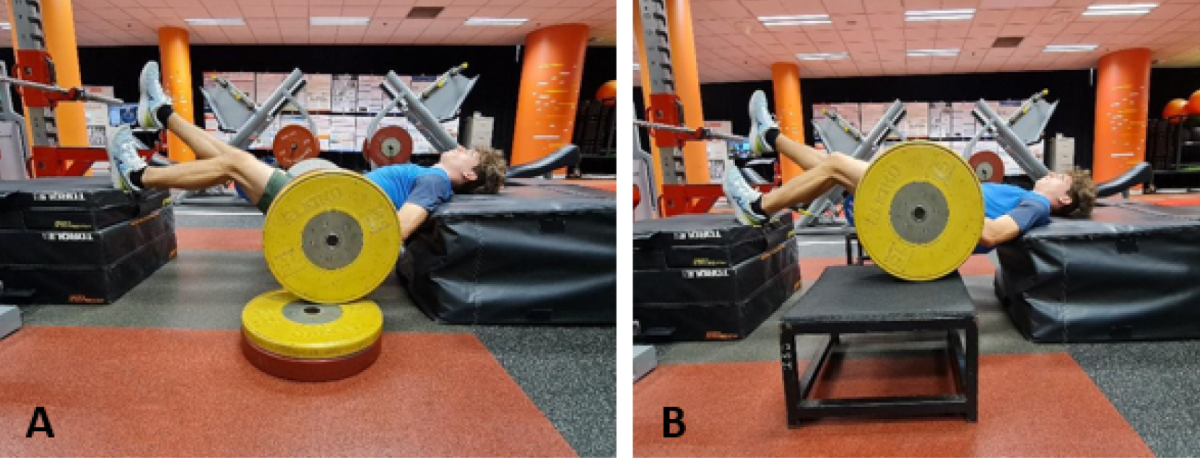
A - Bottom position, B- Top position
Rapid Quasi-Isometric
At a later phase, where the athlete is close to returning to play, they progress to performing the rapid quasi-isometric mode of the hamstring hip thrust. To do this, the athlete must complete a rapid concentric contraction with one leg so that the hip moves upwards rapidly. At the top range of movement, the athlete should rapidly switch the position of both legs and hold the top position for about a second (see figure 4a, 4b and 4c). This is done for 3-4 sets of 5 repetitions on each side. Practitioners may introduce a barbell or a dumbbell at the abdomen to increase the intensity.
FIGURE 4: RAPID QUASI-ISOMETRIC HAMSTRING HIP THRUST

Figure 4a

Figure 4b

Figure 4c
Isometric Staggered Stance Romanian Deadlift
While the hamstring hip thrust trains the hamstring muscles at a position similar to sprinting, the purpose of the staggered stance Romanian deadlift is to prepare the hamstring muscles at long muscle length. Training the muscles at longer lengths would significantly benefit muscle hypertrophy(12).
Begin by having both feet shoulder-width apart. Have one foot moved back about a foot away from the front foot and adopt a staggered stance. Position the barbell below the patellar or tibial tuberosity, depending on the individual’s flexibility. The athlete’s trunk should be closed to be parallel to the ground when holding the barbell with the hip flexed and a neutral spine (see figure 5).
FIGURE 5: HOLD ISOMETRIC STAGGERED STANCE ROMANIAN DEADLIFT

Hold Isometric
The athlete may begin performing the hold isometric with tolerable load at the early rehabilitation stage. Hold each position for 10-30s for 1-3 sets. Most of the weight should be on the front leg. Ensure a neutral spine, brace the core muscles, and maintain retracted scapulars throughout the duration.
“…isometrics effectively assist with pain management.”
Push Isometric
Load the barbell to a weight the athlete can’t lift (see figure 6). Adopt the same position as above. The athlete may then attempt to perform the hip hinge action (stand-up) with >70% maximum voluntary contraction for 2-3 sets of 10-30s. The same movement standards apply as the hold isometric.
FIGURE 6: PUSH ISOMETRIC STAGGERED STANCE ROMANIAN DEADLIFT
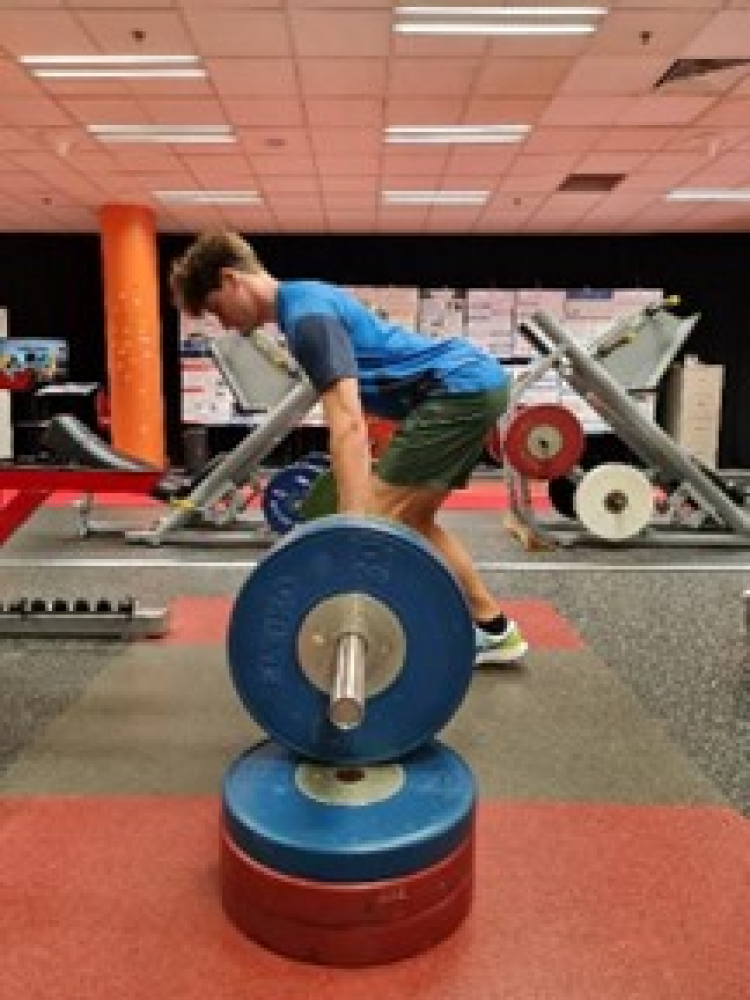
Rapid Quasi-Isometric
The athlete will first adopt an upright position while holding the barbell (see figure 7). The athlete will then be required to partially release the grip on the barbell and let it fall. Then they must catch the barbell rapidly when it gets to just below the knee. The athlete should attempt to hold the position in an isometric state for a second the moment they catch the barbell and avoid eccentric contraction to the hamstring, then return to the starting position. They must ensure a neutral spine when catching the barbell.
FIGURE 7: QUASI-ISOMETRIC STAGGERED STANCE ROMANIAN DEADLIFT
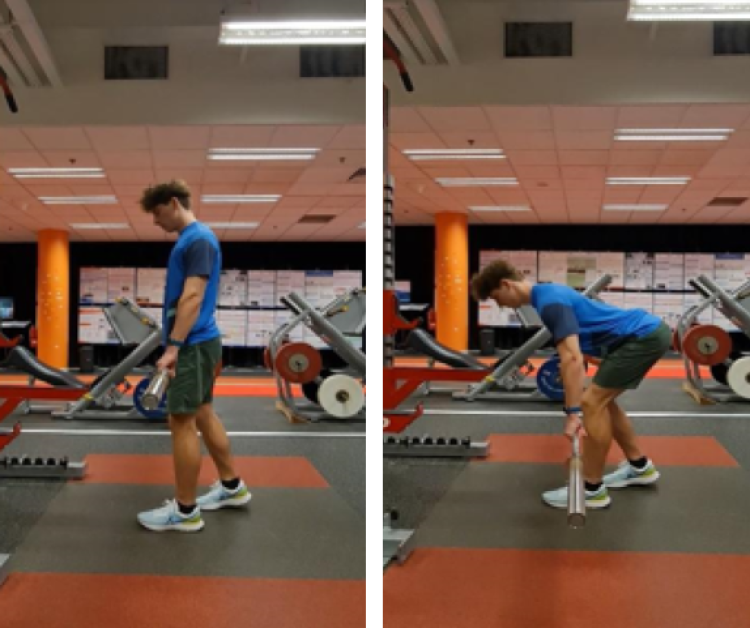
Release the bar, then catch it and hold just below the knee
References
- Br J Sports Med. 2013. 47(12):738–42
- Br J Sports Med. 2023. 57(2):109-116
- Sports Med. 2018. 48:251-267
- J Ath Tr. 2022. 57(2):125-135
- Br J Sports Med. 2023. 57(1):4-6
- J Strength Cond Res 2019. 33(12):3302-3308
- Br J Sports Med. 2015. 49(19):1277-83
- Appl. Physiol. Nutr. Metab. 2012. 37(4):680–89
- Physiol Reports. 2017. 5(15):e13374
- Med Sci Sports Exerc. 2014.46(8):1525–1537
- BMC Sports Sci Med Rehabil. 2022. 14(1):166
- Int J Sports Med. 2019. 40(06), 363-375
Related Files
Newsletter Sign Up
Subscriber Testimonials
Dr. Alexandra Fandetti-Robin, Back & Body Chiropractic
Elspeth Cowell MSCh DpodM SRCh HCPC reg
William Hunter, Nuffield Health
Newsletter Sign Up
Coaches Testimonials
Dr. Alexandra Fandetti-Robin, Back & Body Chiropractic
Elspeth Cowell MSCh DpodM SRCh HCPC reg
William Hunter, Nuffield Health
Be at the leading edge of sports injury management
Our international team of qualified experts (see above) spend hours poring over scores of technical journals and medical papers that even the most interested professionals don't have time to read.
For 17 years, we've helped hard-working physiotherapists and sports professionals like you, overwhelmed by the vast amount of new research, bring science to their treatment. Sports Injury Bulletin is the ideal resource for practitioners too busy to cull through all the monthly journals to find meaningful and applicable studies.
*includes 3 coaching manuals
Get Inspired
All the latest techniques and approaches
Sports Injury Bulletin brings together a worldwide panel of experts – including physiotherapists, doctors, researchers and sports scientists. Together we deliver everything you need to help your clients avoid – or recover as quickly as possible from – injuries.
We strip away the scientific jargon and deliver you easy-to-follow training exercises, nutrition tips, psychological strategies and recovery programmes and exercises in plain English.
